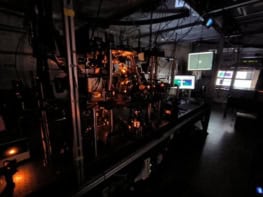Switches made from single molecules could greatly reduce the power consumed by electronic devices, compared to present-day solid-state integrated circuits. Ernst Meyer and Christian Joachim and colleagues from the University of Basle, IBM Zurich and the CEMES-CNRS Lab in Toulouse have now created the lowest energy single-molecule switch to date. It requires only 47 zeptojoules - 47 x 10-21 joules or 0.3 eV - to operate, which is 10 000 times less than the power needed in the transistor switches currently used in high-speed computers (C Loppacher et al. 2003 Phys. Rev. Lett. 90 066107).

The average power consumed by the latest processor chips, such as the Pentium 4, is about 30 W. This is already a problem in some laptop computers where the extra power needed to remove excess heat significantly reduces the life time of the battery.
The switch made by Meyer, Joachim and co-workers consists of a “porphyrin” molecule that has four phenyl “legs” (see figure). Using the tip of an atomic force microscope (AFM) they rotated one of the legs from one stable position to another. The switch is “on” when the leg lies perpendicular to the central part of the molecule and is “off” when it lies parallel.
While the leg is rotated, the researchers record the force-distance characteristics of the structure. In this way they are able to identify the force and energies required to rotate a single carbon to carbon bond in the molecule.
The scientists found that rotating the phenyl leg requires an energy of less than 100 zeptojoules, which is four orders of magnitude lower than state-of-the-art field effect transistors. The researchers believe their method approaches the thermodynamic limit of switching. A machine made of an assembly of such molecular nanodevices could run on a power of less than 100 W.
“This switch could be used to make storage and logic devices, but there are still many problems to be solved,” Christian Loppacher, one of the researchers in the group told PhysicsWeb. “The next stages in our study are the controlled manipulation of these molecules and an investigation into which conditions and on which substrates the molecule legs can be switched”.



